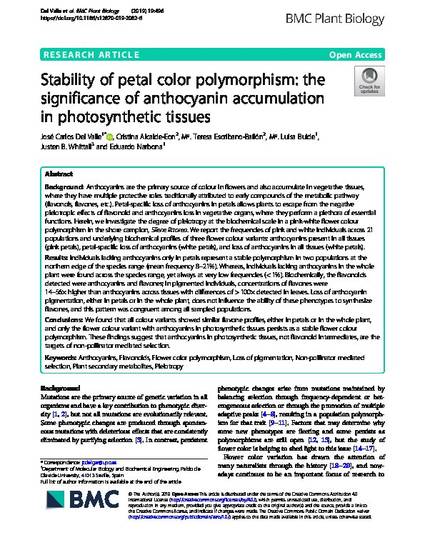
Background: Anthocyanins are the primary source of colour in flowers and also accumulate in vegetative tissues, where they have multiple protective roles traditionally attributed to early compounds of the metabolic pathway (flavonols, flavones, etc.). Petal-specific loss of anthocyanins in petals allows plants to escape from the negative pleiotropic effects of flavonoid and anthocyanins loss in vegetative organs, where they perform a plethora of essential functions. Herein, we investigate the degree of pleiotropy at the biochemical scale in a pink-white flower colour polymorphism in the shore campion, Silene littorea. We report the frequencies of pink and white individuals across 21 populations and underlying biochemical profiles of three flower colour variants: anthocyanins present in all tissues (pink petals), petal-specific loss of anthocyanins (white petals), and loss of anthocyanins in all tissues (white petals).
Results: Individuals lacking anthocyanins only in petals represent a stable polymorphism in two populations at the
northern edge of the species range (mean frequency 8–21%). Whereas, individuals lacking anthocyanins in the whole plant were found across the species range, yet always at very low frequencies (< 1%). Biochemically, the flavonoids detected were anthocyanins and flavones; in pigmented individuals, concentrations of flavones were 14–56x higher than anthocyanins across tissues with differences of > 100x detected in leaves. Loss of anthocyanin pigmentation, either in petals or in the whole plant, does not influence the ability of these phenotypes to synthesize flavones, and this pattern was congruent among all sampled populations.
Conclusions: We found that all colour variants showed similar flavone profiles, either in petals or in the whole plant, and only the flower colour variant with anthocyanins in photosynthetic tissues persists as a stable flower colour polymorphism. These findings suggest that anthocyanins in photosynthetic tissues, not flavonoid intermediates, are the targets of non-pollinator mediated selection.

This article is distributed under the terms of the Creative Commons Attribution 4.0 International License (http://creativecommons.org/licenses/by/4.0/), which permits unrestricted use, distribution, and reproduction in any medium, provided you give appropriate credit to the original author(s) and the source, provide a link to the Creative Commons license, and indicate if changes were made. The Creative Commons Public Domain Dedication waiver (http://creativecommons.org/publicdomain/zero/1.0/) applies to the data made available in this article, unless otherwise stated.